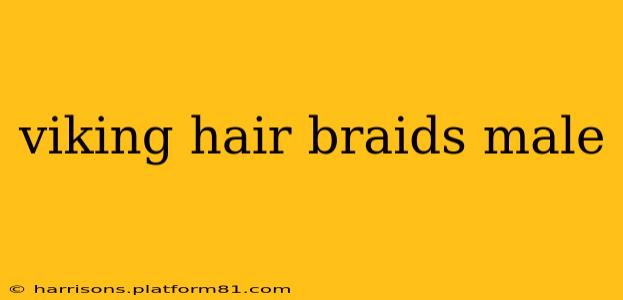The iconic image of a Viking warrior often includes elaborate braids adorning their heads. More than just a stylistic choice, these braids served practical purposes in battle and daily life. This guide delves into the world of male Viking hair braids, exploring their history, styles, and how to achieve them today. We'll even tackle some frequently asked questions to give you a complete understanding of this fascinating aspect of Viking culture.
What Kind of Braids Did Viking Men Wear?
Viking men's hairstyles were diverse, ranging from simple braids to complex interwoven styles. The most common types included:
-
Single Braids: These were often long, thick braids running down the back of the head, sometimes reaching the waist. This style was both practical (keeping hair out of the way) and symbolic (representing strength and virility).
-
Multiple Braids: Vikings also favored multiple braids, often arranged in rows across the scalp or cascading down the sides. The number of braids could vary depending on hair length and personal preference. More braids often indicated higher social status or a warrior's achievements.
-
Combined Styles: Some styles incorporated braids with other elements like ponytails or buns. Hair could be braided partially, with the remaining hair left loose or tied up. The possibilities were as varied as the Vikings themselves.
How to Braid Viking Hair: A Step-by-Step Guide
While precise techniques are lost to history, modern interpretations allow us to recreate Viking hairstyles. The key is to use sturdy braids that can withstand activity.
For a basic single braid:
- Start with clean, dry hair: This will make the braiding process much smoother.
- Gather your hair: Pull all your hair back into a single ponytail at the nape of your neck.
- Begin braiding: Use a three-strand braid technique, keeping the braid tight and consistent.
- Secure the end: Tie off the end of the braid with a strong band or hair tie.
More complex styles require practice and patience. Consider using tutorials available online for visual guidance on creating multiple braids, incorporating beads or other accessories, and achieving more intricate patterns.
Were Viking Braids Only for Warriors?
While the image of a braided Viking warrior is prevalent, braids weren't exclusive to warriors. Both commoners and high-status individuals sported braids, though the complexity and style might have varied according to social standing. Braiding was a practical way to manage long hair, regardless of social class.
What Products Should I Use for Viking Hair Braids?
Achieving authentic-looking Viking braids requires the right products. Consider using:
- Hair wax or pomade: This will provide hold and texture, particularly helpful for thicker hair.
- Hair ties: Choose strong, durable hair ties that won't break easily.
- Hair oil or leave-in conditioner: This will keep hair healthy and manageable, reducing breakage during braiding.
Did Viking Men Use Beads or Other Hair Accessories?
Yes, Viking men frequently used beads, bone pieces, and other small accessories in their braids. These items added a decorative element and might have held symbolic meaning. While exact meanings are lost to time, these accessories added a personal touch to their hairstyles.
How Long Did Viking Hair Braids Take to Create?
The time taken to create Viking braids varied dramatically depending on the complexity of the style and the individual's hair length and thickness. Simple braids could be done relatively quickly, while intricate styles might take considerably longer.
Conclusion
Viking hair braids represent more than just a hairstyle; they were a reflection of culture, status, and practicality. By understanding their history and techniques, we can appreciate their significance and recreate these iconic styles today. Whether you choose a simple single braid or a more complex design, embracing the spirit of the Viking braids is a tribute to a rich and fascinating history.
